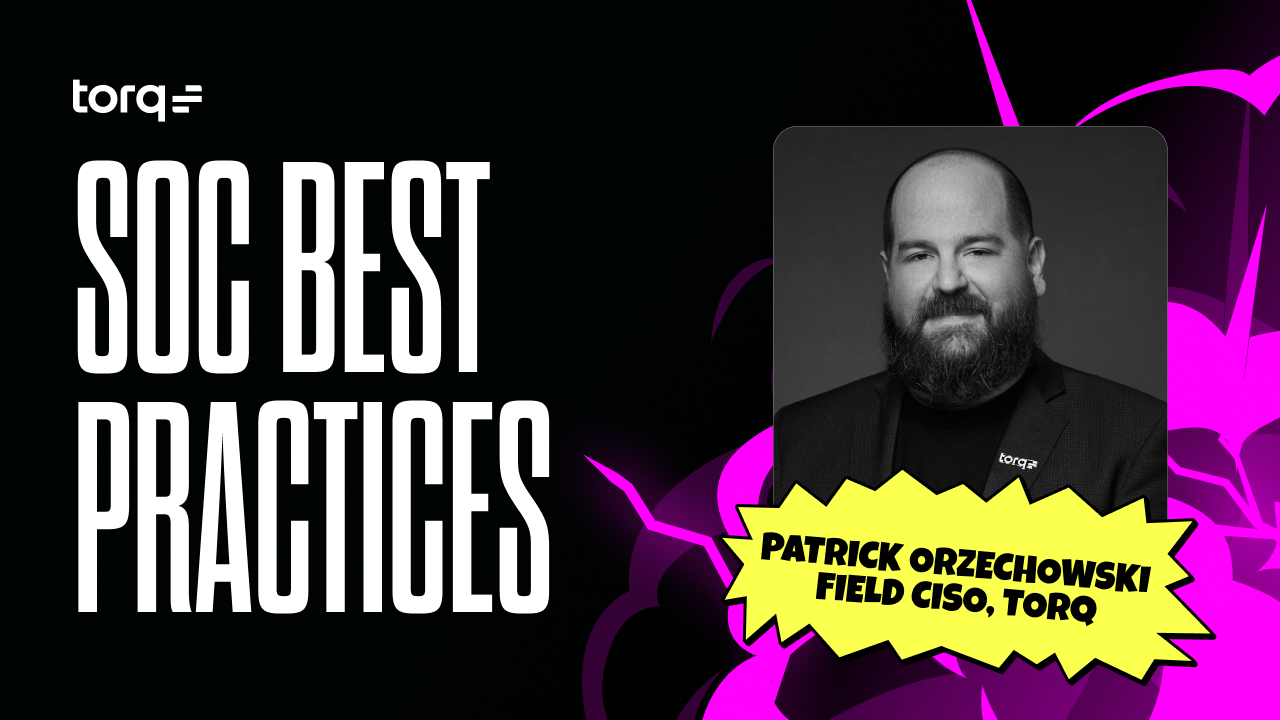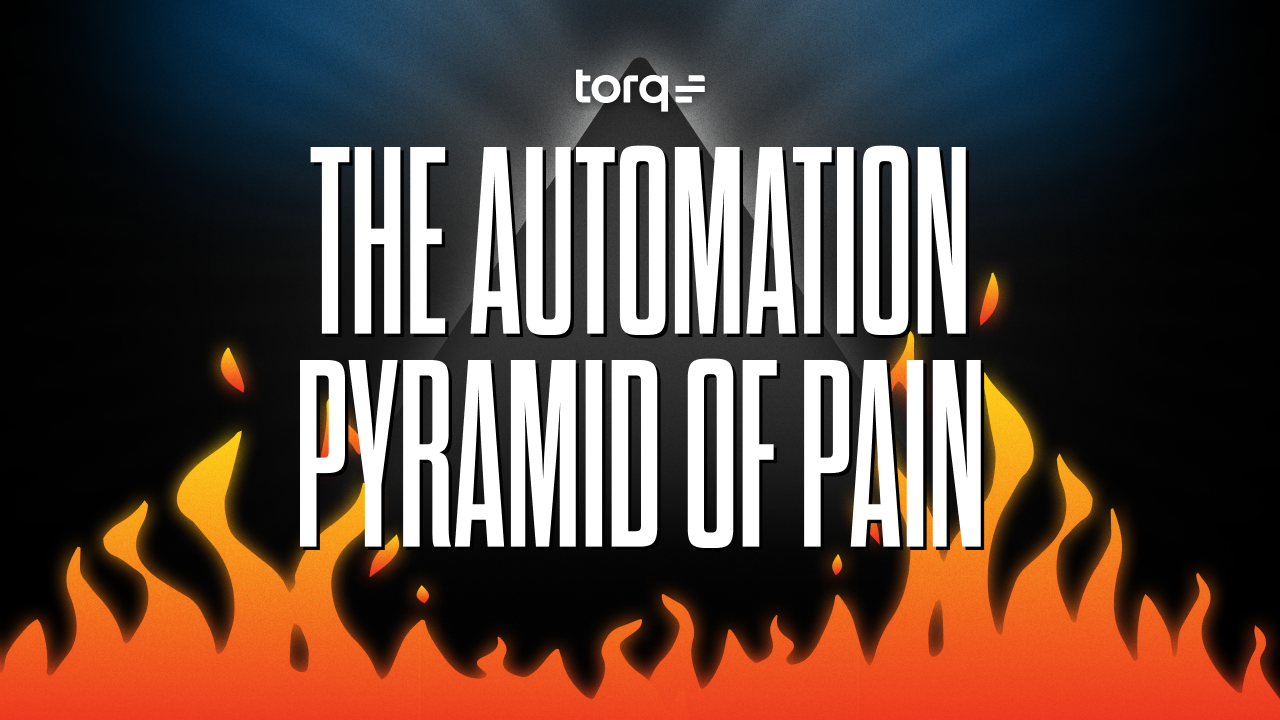Contents
Get a Personalized Demo
See how Torq harnesses AI in your SOC to detect, prioritize, and respond to threats faster.
Running a SOC isn’t for the faint of heart. I should know. Late nights, understaffed teams, endless alerts, and jumping from tool to tool — all fueled by a probably unhealthy amount of energy drinks? Yeah, I’ve been right there in the trenches. And let’s face it: the old SecOps playbooks can’t scale in the face of modern SOC challenges.
The SOC best practices below are the hard-won lessons that separate the security operations centers that struggle to keep up from the ones that position themselves as strategic value centers.
Level Up Your SOC: Best Practices to Stay Sharp and Secure
A Security Operations Center (SOC) brings together people, processes, and technology to manage and improve an organization’s security posture. Put simply, it’s the command center for protecting a business from cyber risk and threats.
In a world where a single data breach can cost millions, an efficient SOC isn’t a luxury — it’s a core business function. An effective security operations center can significantly reduce an organization’s risk by identifying, analyzing, and responding to cybersecurity incidents in near real-time, or better yet, finding and mitigating vulnerabilities before they ever become an incident.
When I ask security operations center leaders the “why” behind the way they built their SOC, most mention that it’s to:
- Proactively prevent cybersecurity incidents by detecting and fixing vulnerabilities, security monitoring, and gathering threat intelligence on known threats.
- Minimize the impact of data breaches by rapidly containing incidents and minimizing their impact on the organization.
- Ensure business continuity by protecting critical assets and data so business operations can continue without interruption.
At the end of the day, all of these drive up to the ultimate goal of a SOC: reducing risk to the business.
5 Most Common SOC Challenges
If you run an SOC, these challenges probably keep you up at night. They’re not just headaches — they’re fundamental risks to your security posture.
1. Alert Fatigue
Alert fatigue is more than just “too many alerts” — it’s a soul-crushing onslaught of low-fidelity noise and false positives that buries the critical alerts that matter. While the cybersecurity industry is a bit of a broken record around alert fatigue, it doesn’t change the fact that most teams are still struggling with it — more than half of security teams say false positives are a huge problem, and nearly two-thirds are overwhelmed by sheer data volume. Alert fatigue burns out already stretched-thin SOC teams, delays threat detection and incident response, and increases the risk of missed threats.
2. Tool Overload
Too many security operation centers I see have sprawling security stacks of disconnected tools that don’t play nice. Security analysts waste precious time swiveling between different UIs and even writing clunky PowerShell or Python scripts to gather information, trying to solve a puzzle with pieces from different boxes.
3. Manual Processes
In 2025, there’s simply no need for human SOC analysts to be manually copy-pasting information from one tool to another to build a case. These repetitive, mind-numbing tasks are slow, prone to human error, and a complete waste of your team’s valuable expertise.
4. Talent Shortage
Finding and retaining top-tier security talent is brutally competitive. The shortage is real, and it means you can’t just throw more people at the problem (especially when budgets are lean). You have to make the team you have exponentially more effective. A crucial part of that is keeping your SOC analysts engaged — automating mundane tasks takes tedious work off their plates, which directly increases morale, boosts productivity, and gives your best talent a reason to stay.
5. Scalability Issues
The volume of data from cloud environments, SaaS applications, and distributed endpoints is exploding, and the security perimeter is larger than ever. A SOC built on manual processes and disjointed tools simply cannot scale to meet this demand. As your business operations — and your attack surface — grows, your security coverage will fall further and further behind unless you start automating.
6. The Ransomware Time-Bomb
Today, every organization of any size is a target for ransomware, and ransomware operators are moving at unprecedented speed, with a median time from initial breach to business-ending payload of less than 24 hours. This breakneck pace demands an immediate and flawless response that is nearly impossible to deliver with manual processes.
7 Security Operation Center Best Practices
Since I started at Torq, I’ve heard the same story from CISOs over and over — they’ve finally reached a tipping point with tech sprawl. They’re looking at unwieldy, expensive security stacks and asking the hard questions: Are these dozens of tools actually making us more secure, or are they just burning out our security analysts and our budget?
This is leading to a massive push for real SOC transformation. The smartest leaders I talk to are no longer content with running a reactive cost center that just cleans up messes. They’re determined to build a proactive, data-driven value center that anticipates cyber threats and demonstrates clear ROI, often by replacing ten disjointed tools with three or four that work together. But getting there requires a fundamental shift in strategy.
The following security operations center best practices are the playbook for that transformation.
1. Build a Strong Foundation with the Right People and Processes
Stop hiring bodies and start building a team. Move from generalized security playbooks to methodical runbooks that combine your security analysts’ expertise with strategic automation and AI augmentation.
2. Prioritize Threat Detection and Response to Your Business Needs
It’s key to shift your team’s focus from managing alerts to actively hunting cyber threats. But with the sheer volume of today’s alerts pinging from sprawling stacks and an explosion of endpoints, the only way to free them up is by leveraging automation and AI to handle the majority of your Tier-1 alerts.
3. Automate the Mundane, Focus on the Critical
Automating repetitive and time-consuming tasks allows your limited resource of human expertise to be focused on more strategic activities, such as threat hunting and investigating complex and critical cases.
4. Embrace Continuous Improvement
The most overused wording in cybersecurity think pieces is probably “the constantly evolving threat landscape,” but the truth still stands. To keep up, SOCs must continuously improve their processes and technologies, which means regularly reviewing and updating security policies, tools, processes, and procedures, tracking and reporting KPIs, and being able to slice and dice case data to pinpoint problem areas.
5. Measure Everything
If you can’t measure it, you can’t fix it. Mean time to investigate, respond, and remediate aren’t vanity metrics — they are the vital signs of a SOC. When you can show your CISO that Hyperautomation slashed MTTI from hours to minutes (like this top 30 U.S. bank did), you’re no longer talking about a cost center; you’re talking about tangible, provable ROI.
6. Be Strategic About AI
AI is the biggest buzzword in security right now, with every vendor promising it can solve all of your problems. But it’s not a magic wand — and there’s a whole lot of AI-washed marketing out there right now. The real power of AI in the SOC is leveraging it to automate away the noise and grunt work and accelerate incident response, so your human SOC analysts can hunt cyber threats and handle complex incidents. And if an AI solution can’t prove its logic with evidence, it’s a black box that will kill trust and has no place in your SOC. See how to deploy AI in the SOC the right way.
7. Consolidate and Optimize
True optimization isn’t a “lift and shift” of your old, inefficient workflows to a new platform — it’s about fundamentally transforming your processes. Torq helps customers escape the tech debt of legacy SOAR by replacing dozens of brittle, code-heavy workflows with a handful of powerful and efficient automations built easily in Torq.
When migrating off a SOAR, Torq customers consistently consolidate their processes, achieving the same outcomes with significantly fewer and more efficient automations, often slashing their workflow count by 30% or more. Get the SOAR migration guide.
The Best SOC Tools
You can’t win today’s fight with yesterday’s technology. What’s the core solution you need to build a modern, autonomous SOC?
Torq HyperSOC
HyperSOC™ is the AI-driven platform I wish I had years ago. Designed specifically to crush the biggest challenges SOCs face, HyperSOC uses powerful, no-code automation to become the connective tissue for your entire security stack, so your cases are managed out of a single interface, and agentic AI autonomously handles 90% of Tier-1 case work.
Here’s how HyperSOC incorporates critical SOC best practices, built in:
- Automates alert triage: HyperSOC ingests the flood of alerts across your stack, using automation and AI to add context, dismiss false positives, and group related alerts into a single, actionable case. It cuts through the noise so your team only sees what truly matters.
- Connects your security tools: Torq has hundreds of pre-built integrations to instantly connect your SIEM, endpoint detection and response (EDR), threat intelligence, ticketing, and communication platforms into seamless, automated workflows.
- Uses no-code, low-code, and AI-generated workflows: With Torq, you don’t need a team of developers to build complex automations. Torq’s drag-and-drop and AI-generated workflow-building capabilities mean anyone can create automations to handle everything from phishing investigation to endpoint containment.
- Supports human-in-the-loop actions: Any AI deployed in the SOC needs to be transparent to be trustworthy. Torq makes it easy to inject human decision points into any AI workflow. Torq’s AI SOC Analyst Socrates can automatically investigate and enrich a case, then present it to a security analyst in Slack or Teams for a final decision on a critical action.
The Foundation for Transformation: Why SOC Best Practices Matter
The days of running a SOC on manual processes and sheer willpower are over. The only way to win against fast, AI-powered adversaries is to fight back with smarter, faster automation. By following security operations center best practices like prioritizing automation, empowering your team with the right tools, and quantifying outcomes through metrics, you can transform your SOC into a strategic value center.
Torq HyperSOC was designed specifically to automate and orchestrate modern SOC operations at scale. Want to learn more about how HyperSOC can help your security operations center get a whole lot more done, a whole lot faster?
Get the SOC Efficiency Guide packed with insights from my years in the trenches as a SOC leader.








